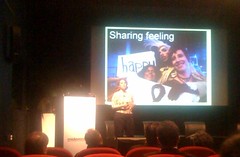Interview: Nancy Baym of Online Fandom (Part 1)
Kyle Bylin, Associate Editor
Today, I spoke with Nancy Baym, who is Associate Professor of Communication Studies at The University of Kansas and author of the Online Fandom blog. After reading Bruce’s write-up about her MidemNet presentation back in January, I became instantly curious and familiarized myself with the rest of her work.
Leading up to me asking if she would share her thoughts on Online Fandom, Mobilized Communities, and The Future of the Networked Audience with the Hypebot community.
Q: What is “Online Fandom?”
Nancy Baym: Online fandom is what happens when people who are passionate about a band (or TV show or whatever) use the internet to discuss, interpret, critique, create new materials around, and otherwise share their experience of whatever it is they are fans of together. It’s actually one of the earliest phenomena to emerge online – the internet’s inventors set up a mailing list called SF-Lovers for science fiction fans to talk about sci-fi over the net in the early 1970s, long before it was even called “the internet.”
Many of the internet’s early developers were Deadheads and they didn’t take long to start adapting the medium to be useful for organizing that community and its practices. After mailing lists came Usenet newsgroups which, along with mailing lists, were the dominant mode of online fandom until the invention of the Web in the 1990s. In the mid 1990s came websites, and now you get fan groups on just about every platform the internet offers.
Over the years online fandom has gotten larger, as more people have begun using the internet and fans who were never able to participate in fandom came online in droves. Online fandom has also become more ambitious as fans realized how much influence they could have online and as technical changes have given fans more means to be creative in their own right by doing things like creating mp3 blogs, making their own videos, and so on.
We’re in an interesting time right now because we finally see artists and their surrogates beginning to reckon with online fandom and becoming active in trying to build it by incorporating fan materials into their own web presence, twittering, and otherwise reaching out to fans online. But it takes more than creating a webboard on your site and assuming the fans will migrate out of their own communities over to your official one.
Bylin: Where twentieth century music culture consisted of being somewhere and social identification through the obtaining of physical possessions, the twenty-first seems to relate more strongly with the everywhere-nowhere phenomenon identified by Neil Randall in ‘Stay in Touch.’ In the sense that, “[Music Culture] will be everywhere, but because it is independent of place, it will be situated nowhere.”
Previously you suggested that, “the sorts of activities fans are doing online have the potential to create the culture in which you will all be operating in the future.”
Q: Could “Online Fandom” become the music culture of the future?
Nancy Baym: A lot of questions in that set up there, let me take it in pieces.
Yes, what happens online will be a huge part of what happens in music culture’s future. The dynamics amongst fans and between fans, bands, and industry that happen online are reshaping the industry and will continue to do so. We are already at a point where the internet is in the middle of music culture, but where it will all end up is still unclear and wide open. The power balance has shifted and will continue to shift so that the entrenched taste-makers – the label A&R people, the mainstream publications like Rolling Stone, the Clear Channel radio programmers – will have less and less influence over music culture. The materials created by and for fans will have more and more influence. Those entrenched channels won’t disappear, but there are and will continue to be many more options for how people discover and organize themselves around music. The entrenched parties will have to adapt to this. Some of them are doing that already, but many are resisting in hopes that maybe legislation or denial will make these threatening changes go away and give them back the power they used to have.
Regarding the question about placelessness, I’m wary of separating this too much from space or assuming that the rise of transnational fandoms means the end of place-based orientations. I disagree that music culture is “independent of place” – the music to which we are exposed, which we seek, with which we identify is very much tied to place, age, and other contexts that shape our identities. Online fandom may help to build local community amongst music fans – but this has been going on for years even without GPS and place-based systems. People in fan groups on the internet have been arranging face-to-face meet ups as long as there have been online fan groups. Furthermore, what fans do online is tightly connected to what they do when they are not online – they hang out in online fan groups and read mp3 blogs and Pitchfork, but they also wear band t-shirts, they talk face-to-face with their friends about music, they go to shows together. This has been part of Trent Reznor’s brilliance. Many of his online strategies have been connected to place – codes on t-shirts, USB sticks in bathrooms, tickets in drainpipes. One cool thing about online fandom is that it opens the door for people to become fans of “local” bands in places they don’t live, so for instance, Swedish independent music has gained a big audience outside of Sweden because of the internet, but it’s still Swedish, and it still involves getting those bands to come to your town so you and your friends can go to your local venue and enjoy them together. What’s local can become international, but it doesn’t have to stop being local as a result.
